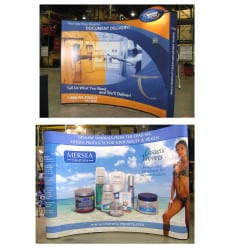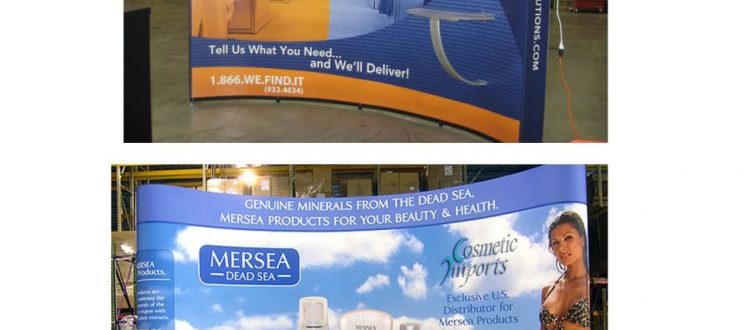Trade show booth designs. Differences between flags & banners. Are banners fire resistant ? And, durability of dye sublimated fabric banners.
Question: What are the basic styles of fabric construction for trade show exhibit booths?
That is a very broad question. Kind of like how do you build a house? But let’s give it a whirl.

Most fabrics that are used for trade show displays are a polyester knit fabric with a small amount of a stretchy material called lycra in it to promote stretchiness.
Why would you want stretchy polyester fabric for your trade show display? First, it does print very nicely when using the dye sublimation printing method. Dye sublimation is the transfer of ink from a carrier paper to synthetic fabrics (most typically polyester or nylon) using heat and pressure, although more recently, direct-to-fabric dye sub printing has become very popular due to it’s comparative speed and ease of production compared to the heat/pressure method.
Secondly, dye sublimation printing for trade show displays on stretchy materials will give you a banner or fabric that will conform to varying shapes of displays, and all without wrinkles. This is why sublimation fabric banner prints have become immensely popular with many companies seeking to out-pull the competition with dynamite cloth banners.
Question: What is the difference between a banner and a flag?
Mainly usage and finishing.
Pole Flags
A flag is typically mounted vertically on a pole, whether using metal grommets or a sewn pole pocket or other fastening styles. Flags are most often used outdoors on vertical poles. They are most often constructed of nylon or polyester, similar to dye sublimation printed cloth banners.
Cloth and Vinyl Banners
Cloth banners, as well as vinyl banners, can be used for decoration (as can flags), advertising (more effective than flags), and are typically hung from a horizontal axis – the top of the banner rather than the side of a flag. Banners are also typically larger than flags, as they are often tacked to the side of a wall or across a street.
The largest flags sold “off the shelf” would be flags such as the 20’ x 30’ US Flag, but very few facilities can afford the cost of the gargantuan flag pole that would fly this flag. Most flags are 18’ x 12’ and smaller, whereas many banners are this size or larger.
Question: Can banner fabric be made fire resistant?
Yes. You simply need to specify, if your specifications require fire retardency as part of the makeup of your dye sub cloth or fabric banner, that a banner or banners you’re ordering are going to need to be fire retardant. This is becoming increasingly common, particularly in areas that are expecting large crowd of people.
The cloth banner material is treated in the manufacturing process with a fire retardant spray, and then sent to printers who print fire retardant banners as specified by the client.
Question: How long will my dye sublimation printed fabric banners last?
That will depend on how your using them.
Outdoor Use
If you order an outdoor fabric banner, it is likely that you could get two to three years out of it, if it is not in a high wind area, it is not always being beaten upon by the sun, and small children are not able to jump up and hang from it.
Indoor Display
Indoors, if there is not too much sunlight coming in from skylights or large windows, these cloth dye sub banners could last even longer. The good news with dye sub printing is that the ink is sublimated into the fabric. The bad news is that ink, of any type, will fade over time in the sunlight. But you should still get many months of good usage from your banners.
For more about dye sublimation printed fabric banners, check here. If you got questions, you can leave them on the comment form below.
Popular Posts:




